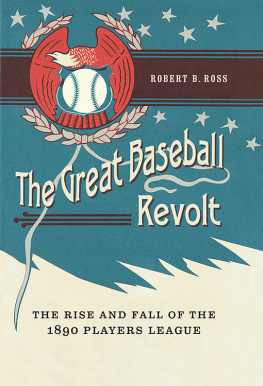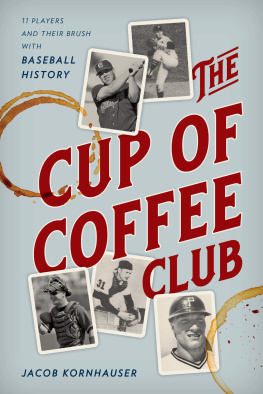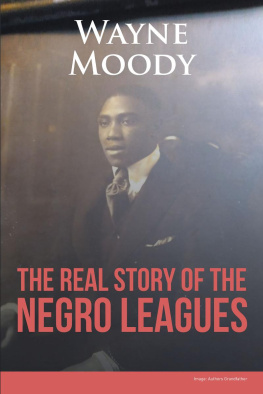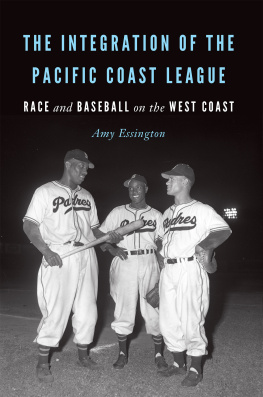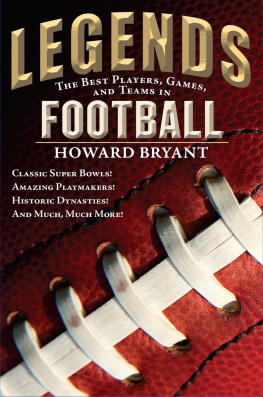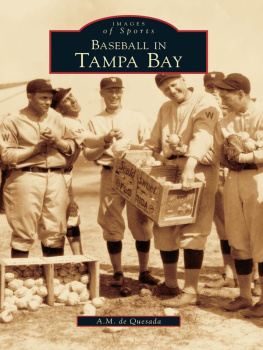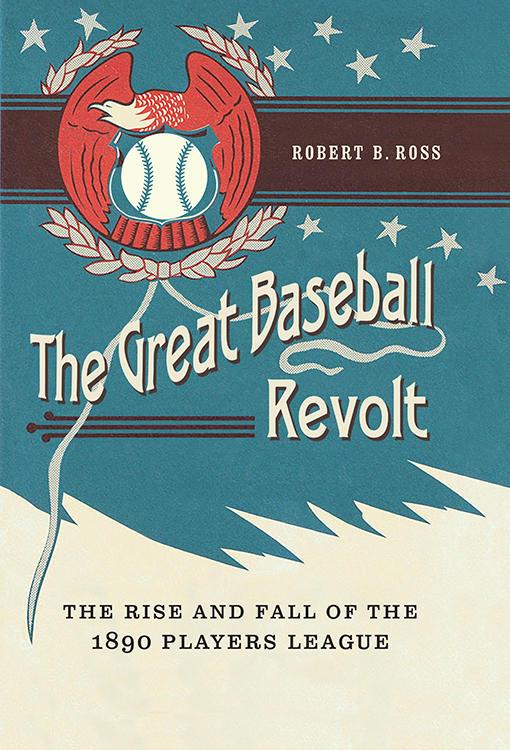Robert B. Ross
2016 by Robert B. Ross. Portions of chapters 1, 2, 3, and 7 were published in Robert Ross, Contradictions of Cultural Production and the Geographies That (Mostly) Resolve Them: 19th-Century Baseball and the Rise of the 1890 Players League, in Environment and Planning D: Society and Space 26, no. 6 (2008): 9831000. Portions of chapter 5 were published in Scales and Skills of Monopoly Power: Labor Geographies of the 18901891 Chicago Carpenters Strike, in Antipode 43, no. 4 (2011): 12811304.
All rights reserved.
Title: The great baseball revolt: the rise and fall of the 1890 Players League / Robert B. Ross.
Includes bibliographical references and index.
ISBN 9780803249417 (cloth: alk. paper)
Subjects: LCSH : Players League (Baseball league)History. BaseballUnited StatesHistory19th century.
Classification: LCC GV 875. P 55 . R 67 2016 | DDC 796.357/64097309034dc23 LC record available at http://lccn.loc.gov/2015035768
The publisher does not have any control over and does not assume any responsibility for author or third-party websites or their content.
This book is dedicated to the memory of my father, Robert B. Ross Sr. May he rest in peace and may the Orioles win the World Series.
This book was ten years in the making. It traveled with me from Syracuse to Cooperstown, to Brooklyn, to Beirut, back to Syracuse, and finally to Pittsburgh. I am afraid it will be impossible to acknowledge everyone who contributed to its development and completion. But I will try.
The following institutions provided various resources that helped make this book possible: Syracuse University; the Syracuse University Graduate School; the Maxwell School for Citizenship and Public Affairs; the Syracuse University Department of Geography; the Roscoe Martin Fund; the Chicago Historical Museum; the National Baseball Hall of Fame Library in Cooperstown (particularly Tim Wiles and John Horne); Sunnys Bar; the New York Public Library; the Brooklyn Public Library; the Boston Public Library; New York University and the Tamiment Labor Archives; the Society for American Baseball Research; the Tri-State College of Acupuncture; the Brooklyn Artists Gym; Room 58; the Pioneer; the American University of Beirut and its Center for American Studies and Research; the University of Nebraska Press; the University of Pittsburgh; the Heinz History Center; the Pittsburgh chapter of Orioles club; Espresso a Mano; Point Park University, including its Office of Academic and Student Affairs, the School of Arts and Sciences, the Department of Humanities and Human Sciences (especially Kim Bell, Kris Julian, and Julie Russell), and the Global Cultural Studies Program. The librarians at Point Park deserve special mention. Liz Evans, Dev Albarelli, Lauren Irwin, Melanie Kirchartz, Margie Stampahar, Robert Stancampiano, and Mandee Williams, in particular, went above and beyond the call of duty to help me track down various sources and resources.
Several professors have instructed, inspired, and encouraged me over the past twenty years. They have all contributed, whether directly or indirectly, to The Great Baseball Revolt. At the top of this very long list are Don Mitchell, Richard Dennis, Paul Stoller, Tod Rutherford, Jamie Winders, John Mercer, Leigh Shaffer, Helen Berger, James Trotman, Joan Welch, James Kneale, Ann Varley, Linda McDowell, and Sudipta Sen.
My dissertation committee at Syracuse University played the most direct role in helping me develop and shape this book. Chief among them is Don Mitchell. I will forever be indebted to him for his extraordinarily helpful supervision and for the example he continues to set as a radical scholar and teacher. This book would never have gotten off the ground, however, if not also for the countless hours that Tod Rutherford, Jamie Winders, John Mercer, Mike Wasylenko, and Richard Dennis spent reading and responding to its various drafts. Their critiques and suggestions allowed me to see the works weaknesses as well as its strengths, particularly in relation to the research process itself. Gavin Bridge and Anne Mosher played foundational roles in helping me get this research started in the first place.
The Society for American Baseball Researchs Nineteenth Century Research group has served as a valuable resource for learning about the minutia and broader trends of early baseball. Three researchers among this group have been especially helpful: David Stevens, the author of Baseballs Radical for All Seasons: A Biography of John Montgomery Ward, Don Jensen, whose research on Helen Dauvray provided many important ideas related to John Ward, and John Thorn, official historian for Major League Baseball. More recently, Craig Britcher offered some excellent insight into Lou Bierbauer and the chaos that ensued after the Players League fell.
Brook Sloan got to know this book very well, and I am indebted to her for her feedback and friendship. Matt Huber, Jim Ketchum, and Megan Ward have read more-recent parts of the book and offered much-needed suggestions and encouragement. I thank Rob Taylor, at the University of Nebraska Press, for taking on this project in the first place and for his helpful guidance throughout. Tish Fobben, Courtney Ochsner, Rosemary Vestal, Barbara Wojhoski, and Joeth Zucco, along with everyone else at the University of Nebraska Press, have also worked tirelessly to help me complete this project.
My health and well-being, which needed a bit of maintenance over the past ten years in order to write this book, owe a lot to the work of Mary Hart, Betty Lerer, Moriah Ella Mason, Tyler Phan, and Anne-Francois Potterat.
A number of students have played vital roles in the development of my thinking, research, and writing, including, especially, Sara Ajlyakin, Abrar Al Mubarak, Ana Bird, Jewell Bohlinger, Karen Bullock, Mert Chapulcu, Kelly Cline, Lindsay Dill, Hannah Gerbe, Hind Ghandour, Holden Holden, Ian Horne, Rachel Johnson, Lamis Jamil, Bella LaQuatra, Samey Lee, Mallory Locante, Sean McKeag, Alex Munroe, Eric Probola, Lisa Rectenwald, Glen Keith Richards, Julia Richards, Robyn Roux, Tyler Shoaf, Hannah Simon, Casy Stelitano, Ian Sulkowski, Maddy Toy, Hana Valle, and Ben Zebrasky, among countless others.
I am fortunate to have a growing group of colleagues and friends at each of the institutions where I have worked and studied and across the broader academy. I am deeply grateful for their support, both personally and professionally. These folks are often the intellectual and emotional fuel that keeps me moving: Jeremy Braverman, Bill Breslove, Carrie Breitbach, Lisa Bhungalia, Elizabeth Campbell, Tracy Carty, Jason Cross, Karen Dwyer, Jamey Essex, Cindy Franklin, Dwight Hines, Matt Huber, Laam Hae, Euan Hague, Kirstin Hanley, Sami Hermez, Matt Hidek, Matt Himley, Noel Ignatiev, Jim Ketchum, Marisa Lerer, Jenna Loyd, Patrick McGreevy, Alyson Newquist, Tony Novosel, Reecia Orzeck, Sarah Perrier, Bill Purcell, Jehnie Reis, Clayton Rosati, Sarah Schulz, Ron Smith, Tom Slater, Joaquin Villanueva, Patrick Vitale, Megan Ward, Kristine Weatherston, Katie Wells, and Erica Lorraine Williams.

